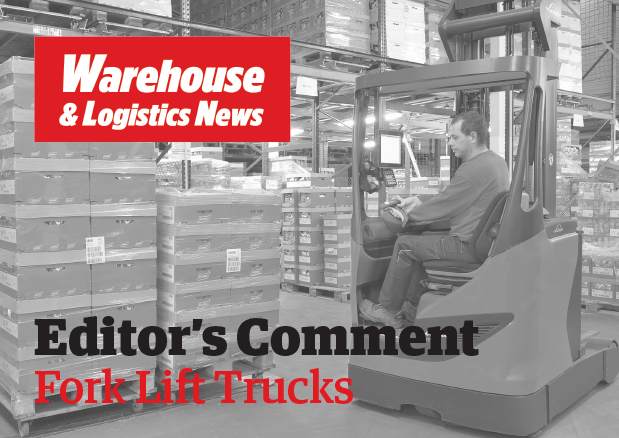Forklift sustainability has become a major consideration among big buyers and so minds inevitably gravitate towards motive power with a strong, growing predilection for electric trucks. But that does not mean that IC trucks are being neglected in the sustainability stakes. Stephan Prokosch, senior vice president product management, industrial trucks – counterbalance at Linde Material Handling, says that IC drive will remain the number one choice for many customers for the foreseeable future owing to its strong performance and straightforward use. “That’s why we attached great importance to optimising the energy consumption and increasing the handling capacity, while removing emissions at the same time,” he said during Linde’s launch last November of its next generation of counterbalance forklifts.
This article was first published in the April 1st 2020 issue of Warehouse & Logistics News, subscribe to the magazine by clicking here.
 Those in the electric camp, however, say that lithium-ion batteries are proving popular with customers as they can offer greater productivity and improved total costs when used in the right application and with a power punch to match diesel or gas IC trucks in all weathers. With these batteries there is no need for stand-by batteries for 24/7 operation, unavoidable with lead-acid batteries, and their technology advances continue apace. Take, for example, BYD, who went down the lithium ion-phosphate route 10 years ago. To celebrate its 10th anniversary as a global leader in zero emission vehicles, it is launching its dual-charging system promising its customers industry-leading recharge speeds significantly faster than comparable lithium-ion battery systems. The dual charging system offers two charging ports, effectively doubling the charging speed when connected to a pair of charger guns, which means recharge takes only an hour and it can be topped up during short breaks with no detrimental effects to the battery, so ensuring maximum uptime at lowest possible cost.
Those in the electric camp, however, say that lithium-ion batteries are proving popular with customers as they can offer greater productivity and improved total costs when used in the right application and with a power punch to match diesel or gas IC trucks in all weathers. With these batteries there is no need for stand-by batteries for 24/7 operation, unavoidable with lead-acid batteries, and their technology advances continue apace. Take, for example, BYD, who went down the lithium ion-phosphate route 10 years ago. To celebrate its 10th anniversary as a global leader in zero emission vehicles, it is launching its dual-charging system promising its customers industry-leading recharge speeds significantly faster than comparable lithium-ion battery systems. The dual charging system offers two charging ports, effectively doubling the charging speed when connected to a pair of charger guns, which means recharge takes only an hour and it can be topped up during short breaks with no detrimental effects to the battery, so ensuring maximum uptime at lowest possible cost.
If potential buyers of new trucks have any doubts about electric’s power punch vis-a-vis diesel/gas then STILL’s re-issued RX60 launched last September based on battery power should dispel doubts. This is aimed at the crucial 2.5-3.5 t market because two thirds of the existing market in this segment is served by IC engines, so any high-performing electric model will concentrate minds. At nine hours it can go longer than a standard shift before needing a recharge. Its ergonomics are improved along with its efficiency. Of the two versions, standard and high performance, the latter allows user to make that switch from IC to electric trucks with confidence that the full performance is as promised. The lithium-ion batteries ensure 3-shift working without replacement batteries. While still on heavy duty electric forklifts, visitors to the Mach 2021 rescheduled exhibition (January 2021, NEC), might care to check out Doosan’s latest 3-wheel counterbalance electric truck, the B13R-7, for lifting 3 t loads.
Automated, autonomous forklifts will undoubtedly make more inroads in the warehouse market, and being electric powered they will replace IC engine trucks, making them more sustainable in terms of the environment, provided the power is generated from non-fossil fuelled power stations. Super-sized sheds have enough roof space to generate clean power from solar panels, something that Honda’s car plant did to power its handling fleet.
Bill Redmond, Features Editor




Comments are closed.